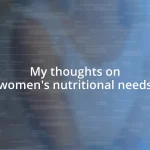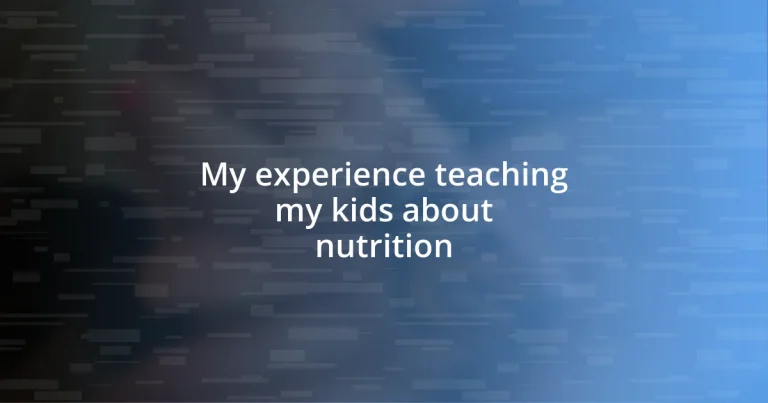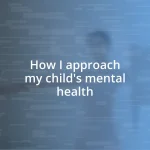Key takeaways:
- Empowering children through hands-on activities, like cooking and grocery scavenger hunts, enhances their understanding of nutrition and promotes healthy food choices.
- Engaging in discussions about food during meals encourages critical thinking and a deeper connection to their eating habits, making them active participants in their health journey.
- Utilizing resources such as online tools, children’s cookbooks, and documentaries fosters continued learning and excitement about nutrition in an enjoyable, interactive way.

My motivation for teaching nutrition
Teaching my kids about nutrition stems from my own experiences in childhood. I vividly remember the confusion I felt when my family faced health issues due to poor eating habits. If I had been better equipped with nutritional knowledge back then, could things have turned out differently? That thought drives me to give my children the tools they need to make healthier choices.
I often reflect on my journey of learning how food impacts our lives. It wasn’t until I researched food labeling and the importance of whole foods that I truly understood the power of nutrition. One afternoon, while cooking together, my son asked why we opt for fruits instead of sugary snacks. His curiosity reminded me that these discussions can spark interest and emphasize the importance of mindful eating.
I genuinely want my children to feel empowered by their food choices. I recall a moment when my daughter created a colorful smoothie filled with fruits and veggies. The pure joy on her face as she enjoyed something healthy made me realize that nutrition education isn’t just about the facts; it’s about creating positive, enjoyable experiences around food. How rewarding it is to see them take pride in what they eat!

Identifying key nutrition concepts
Understanding key nutrition concepts is essential for cultivating healthy habits in children. One evening, while preparing dinner, my daughter asked why we choose certain ingredients over others. This opened up a delightful conversation about macronutrients—carbohydrates, proteins, and fats—which are the building blocks of our diet. I realized that these moments not only clarify complex subjects but also help them connect the dots between food choices and their impact on their bodies.
Here are some fundamental nutrition concepts we often explore together:
– Whole Foods: Emphasizing the importance of minimally processed foods helps them appreciate the flavors and nutrients in fresh fruits and vegetables.
– Balanced Meals: We talk about how each meal should include a mix of macronutrients for energy and growth.
– Hydration: I remind them that drinking water is crucial for our overall health and can be more refreshing than sugary drinks.
– Portion Sizes: Teaching them about appropriate portion sizes encourages mindful eating and prevents overeating.
– Reading Labels: Together, we read food labels to foster understanding of ingredients, sugar content, and nutritional value.
Through these discussions, I’ve noticed my kids becoming more thoughtful about what they eat. It brings me joy to see their curiosity blossom into a genuine interest in nutrition.

Creating engaging learning activities
Creating engaging learning activities around nutrition has been a transformative experience for my kids and me. One of the most memorable activities we did involved a scavenger hunt at the local grocery store. I gave them a list of healthy foods to find, which turned into a fun competition. Not only did they learn about fresh produce, but they also engaged in a lively discussion about the health benefits of each item. Seeing their excitement as they checked off each item reminded me how hands-on experiences can make lessons stick.
Another activity that has really resonated with my children is cooking together. We transformed simple recipes, letting them choose ingredients and experiment with flavors. I remember one particular day when my son decided to add a hint of cinnamon to a vegetable dish, and we all loved it! This process of exploring flavors teaches them about nutrition in such an enjoyable way. I’ve come to realize that when they take part in creating their meals, it fosters a sense of ownership over their food choices.
Lastly, we incorporated fun games into our learning. For instance, we created a “Nutrition Charades” game where we acted out different foods and their benefits. This not only makes the learning process lively but also reinforces their understanding in an imaginative manner. I often find myself laughing and thoroughly enjoying these moments, knowing they’ll remember the fun we had as they grow.
| Activity | Benefits |
|---|---|
| Grocery Store Scavenger Hunt | Encourages exploration and understanding of fresh foods |
| Cooking Together | Builds confidence and inspires creativity in meal preparation |
| Nutrition Charades | Makes learning fun and reinforces nutritional knowledge |

Incorporating real-life food choices
When it comes to real-life food choices, I often turn to our family meals as teaching moments. Recently, I made a homemade pizza with my kids, letting them choose their toppings. It struck me how enthusiastic they were about selecting vegetables like bell peppers and spinach, especially when I pointed out how colorful their choices were. Isn’t it fascinating how involving them in food prep can spark their interest in healthier options?
We also love discussing our grocery trips. The other day, I asked; “Which fruits do you think will help keep your energy up for soccer practice?” Their eyes lit up as we moved through the aisles, and I watched them reach for bananas and berries. It’s incredible to see them connect the dots between what they eat and how they feel afterwards. It’s not just about fueling their bodies—it’s about learning to make choices that support their active lifestyles.
I’ve found that incorporating real-life situations, such as planning meals for the week, makes nutrition lessons even more relevant. One evening, as we sat together with a notepad, my daughter confidently suggested we should include more grains and legumes. I felt an overwhelming sense of pride! It dawned on me—when kids participate in meal planning, they not only expand their knowledge but also develop critical thinking about their choices. How rewarding it is to witness them evolve into miniature nutritionists!

Fostering healthy eating habits
Fostering healthy eating habits goes beyond teaching the basics; it’s about creating a meaningful connection to food. One morning, I set up a “breakfast bar” where my kids could choose healthy toppings for oatmeal. Watching them pile on fresh fruits and nuts, you could see the pride in their faces. It made me realize that by giving them options, I was empowering them to make choices, which is a powerful way to instill lifelong habits.
In my experience, discussing food choices during our meals reinforces these healthy habits further. I often ask my kids what they think about the ingredients we use, and it often leads to heartfelt conversations about health and wellness. Just the other night, my daughter mused aloud, “Do you think eating more greens makes us stronger?” It warmed my heart to see her curiosity blossoming. Encouraging such dialogue not only makes them more aware but also helps them develop a genuine relationship with what they eat.
Moreover, I’ve learned the importance of modeling healthy behaviors myself. When they see me enjoying a colorful salad or snacking on fruits, they’re more likely to mirror those choices. I fondly remember a family picnic where my kids dug into a vibrant fruit platter I prepared, and one of them exclaimed, “This is better than cookies!” It’s moments like these that reaffirm the positive influence we have as parents. After all, who doesn’t love a little bit of fruit as a treat? Isn’t it amazing how our habits can inspire our children?

Measuring progress in kids’ understanding
Tracking my kids’ understanding of nutrition has been quite the adventure! I remember when we first started our journey; my son struggled to name any vegetables beyond the typical carrots and peas. Fast forward a few months, and he confidently pointed out kale and avocados at the farmer’s market. It felt like a small triumph, and I was amazed by how quickly they absorbed information just by making it fun and interactive.
Another way I measure their progress is through the open-ended questions we share during mealtime. Just last week, I casually asked my daughter, “What do you think makes a meal balanced?” She paused for what felt like an eternity before enthusiastically listing proteins, veggies, and grains. Her sparkle eyes and proud grin told me she understood the concept well—she was no longer a passive eater; she was an active participant in her health journey. Don’t you think it’s powerful when kids articulate their thoughts about something as fundamental as food?
I also love using playful quizzes to solidify their knowledge. One evening, we had a “nutrition trivia night” where I quizzed them on food groups and health benefits. To my delight, they competed to answer faster, treating it like a game. Watching their excitement transformed the learning process into something they genuinely enjoyed. Isn’t it incredible how playful competition can ignite their passion for nutrition?

Sharing resources for continued learning
I often turn to online resources to keep the momentum of our nutrition learning alive. Websites like ChooseMyPlate.gov offer interactive tools that engage kids in understanding food groups, making it easy to transform learning into a playful experience. Just the other day, I saw my daughter eagerly completing one of the quizzes on the site. The giggles and excitement that erupted reminded me of just how much they enjoy connecting with these resources.
Another treasure I discovered is the children’s cookbook section at our local library. We made it a weekend ritual to explore new recipes together, and this introduced them to various cultural foods. When we tried our hand at making homemade sushi, the look on my son’s face as he rolled bamboo was priceless! He declared, “This is like a food adventure!” It’s remarkable how hands-on activities can turn unfamiliar concepts into exciting explorations of taste and nutrition.
I also encourage them to watch kid-friendly documentaries about food and farming. A couple of weekends ago, we settled down for a film that followed farmers and their sustainable practices. Later, my kids couldn’t stop asking questions about where their food comes from. This curiosity taught me that fostering continued learning is often about sparking their interest rather than simply delivering facts. Have you ever noticed how a good story can create lasting impressions?














